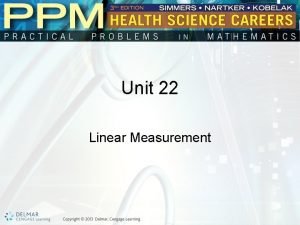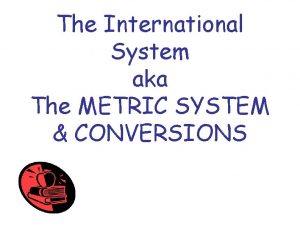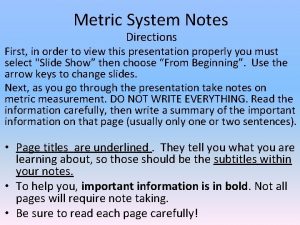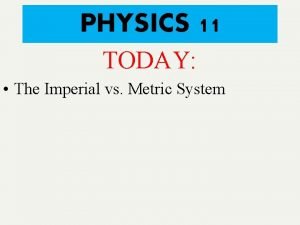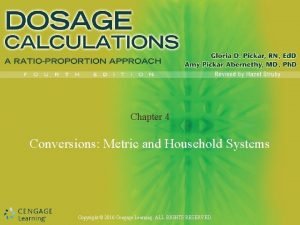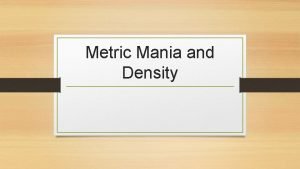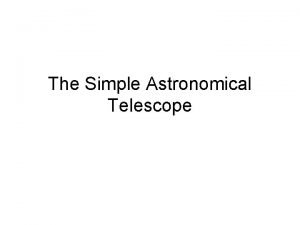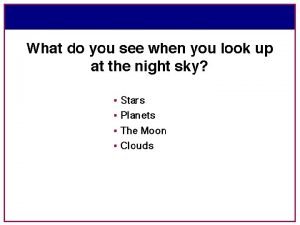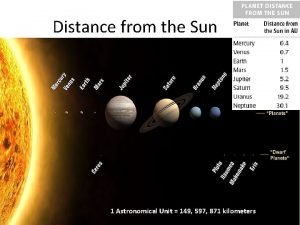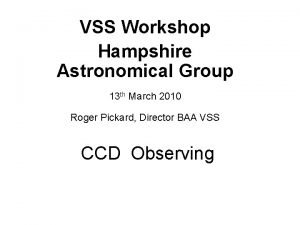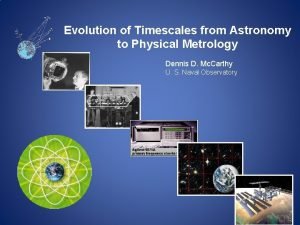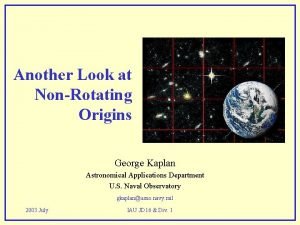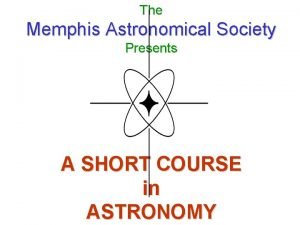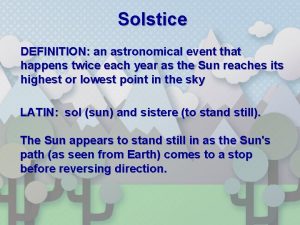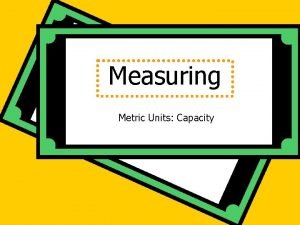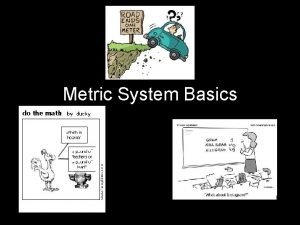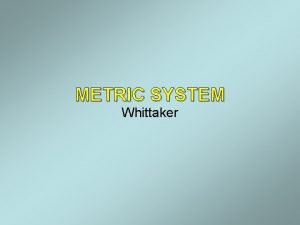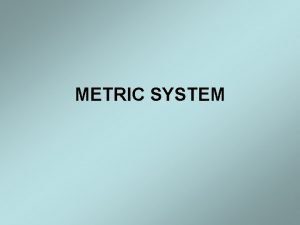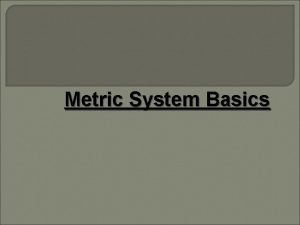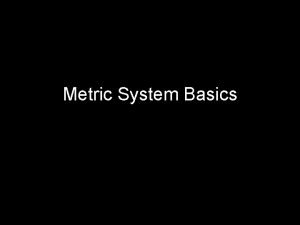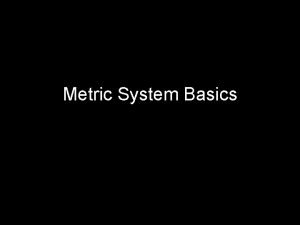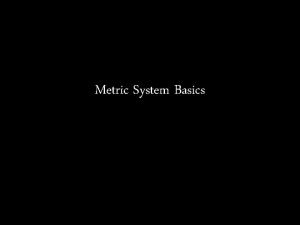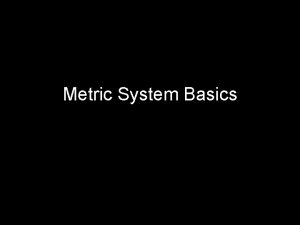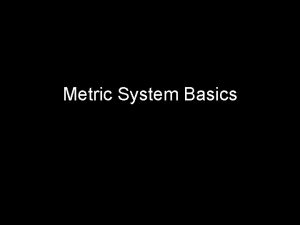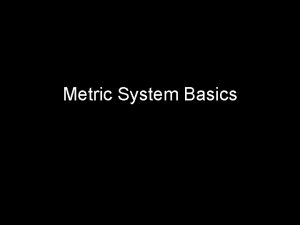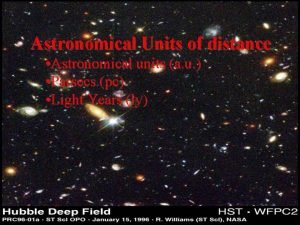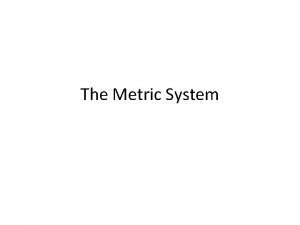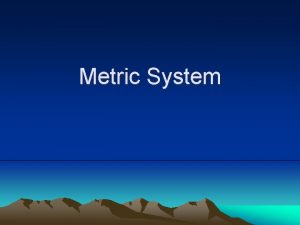Measurements Units Astronomical Measurements the Metric System Units
















- Slides: 16

Measurements & Units

Astronomical Measurements – the Metric System • Units of length: – meter (m) 1 yd. 4 in. – kilometer (km) = 1000 m or about 0. 6 mi. • Units of mass: – kilogram (kg). 1 kg weighs about 2. 2 lbs. (lb. =unit of weight) • Units of time: – second, same as in the English system

Light Years and Parsecs • A light year (ly) is the distance light travels in a year – About 1016 m (~6 trillion miles) • Speed of light is 3 108 m/sec or 186, 000 mi/sec – A unit of distance, not time! – Observable universe is ~1010 (10 billion) ly in diameter • A parsec (pc) is a slightly larger unit of length – 1 pc = 3. 3 ly

The Universe is structured on different length scales Stars nebulae molecular clouds star clusters THE UNIVERSE clusters and superclusters galaxies like the Milky Way quasars Solar System black holes pulsars Sun planets terrestrial jovian moons comets meteors asteroids dust voids Big --------------- small

Different lengths scales Different length units • Human scale: meters (yards) – Human height: 1. 8 m • Geographical scale: kilometers (miles) – Distance to Cincinnati: 100 mi • Solar system scale: Astronomical Unit – Distance Earth-Sun: 1 A. U. • Intragalactic scale: lightyears (parsecs) – Next star: 4 lightyears • Intergalactic scale: millions of lightyears (Megaparsecs) – Andromeda galaxy: 2. 2 million lightyears = 0. 67 Mpc • Cosmological Scale: billions of ly (Gigaparsecs) – Edge of observable universe: about 15 billion ly

Different lengths scales Different length measurements • • Human scale: yardstick Geographical scale: triangulation Solar system scale: Radar ranging Intragalactic scale: – Close stars: stellar parallax – Far: spectroscopic parallax • Intergalactic scale: – Close: Variable stars – Far: Tully-Fisher relation • Cosmological Scale: Hubble’s Law

Units • Dimensions and units are different! • To convert from one unit to another use conversion factors – 2 miles = (2 mi)*(1) = (2 mi)(1600 m/1 mi) = 3200 m

Performing Experiments • Experiments must be repeatable – requires careful control over variables • Possible outcomes of an experiment: – The experiment may support theory • We then continue to make predictions and test them – The experiment may falsify theory • We need a new theory that describes both the original data and the results of the new experiment • Since we cannot do every possible experiment, a theory can never be proven true; it can only be proven false

Making Measurements • Errors – Random – Systematic • With every measurement, it is essential to provide an estimate of the uncertainty – the likely range of errors • Example: – Using a ruler marked in mm, we round to the nearest marking – at most off by half a division, or 0. 5 mm – Cite a measurement of 15 mm as 15 0. 5 mm to indicate that the real value of the length is likely to be anywhere between 14. 5 mm and 15. 5 mm – If a theory predicts a value of 15. 2 mm, then a reading of 15 0. 5 mm is in agreement with theory but a reading of 15 0. 1 mm is probably not

Activity – Analyzing the Results • Why aren’t all the results the same? • How do we compare results? • What kind of errors occurred? • Is our error small or big? • Is our result precise, accurate or what? • So, do our results agree?

Why aren’t all the results the same? • Useful questions to ask, if results don’t agree: – Which object did you measure? – What units where you using? – What is your estimated error?

How do we compare results? • Don’t compare apples with oranges! • Need to use the same units • 1 inch = 2. 54 cm • To get inches from centimeters, divide by 2. 54 • To get centimeters from inches, multiply by 2. 54

What kind of errors occurred? • There are systematic and random errors • To beat down random errors, measure the same thing many times, and the errors will even out, i. e. the overall error will be smaller • The systematic error can be reduced by doing a better experiment, or understanding your instruments better (miscalibrations etc. ) • Human error is not an acceptable error source in science! It just means you are a bad experimenter.

Is our error small or big? • It depends! • If you have a small error and the measured length is also small, you might have a huge error! • Use percentages: – Percent error = (estimated error)/(result) x 100% – Example: 51. 3 cm ± 0. 2 cm gives – Percent error = (0. 2 cm)/(51. 3 cm) x 100 % = 0. 4 % (This is a pretty small error)

Is our result precise or accurate or what? • • Two different concepts: precision and accuracy! High precision means small error High accuracy means close to an accepted value Examples: **** high precision, high accuracy **** high precision, low accuracy * * * * accepted value * low precision, high accuracy low precision, low accuracy

So, do our results agree? • Results agree, if they are within the error margins of each other • Examples: | O | values very different, but errors large: agreement! | O | values closer, but errors smaller: no agreement!
 Units of linear measurement
Units of linear measurement Km hec dec m dm cm mm
Km hec dec m dm cm mm Base units for metric system
Base units for metric system Who uses imperial system
Who uses imperial system Apothecary conversion chart
Apothecary conversion chart Metric mania conversion challenge
Metric mania conversion challenge Angular magnification
Angular magnification Astronomical coordinates
Astronomical coordinates What is an astronomical unit
What is an astronomical unit Hampshire astronomical group
Hampshire astronomical group Astronomical time scale
Astronomical time scale Star collimation
Star collimation International association of astronomical artists
International association of astronomical artists Guildford astronomical society
Guildford astronomical society Astronomical applications department
Astronomical applications department Memphis astronomical society
Memphis astronomical society Astronomical event that occurs twice a year
Astronomical event that occurs twice a year
